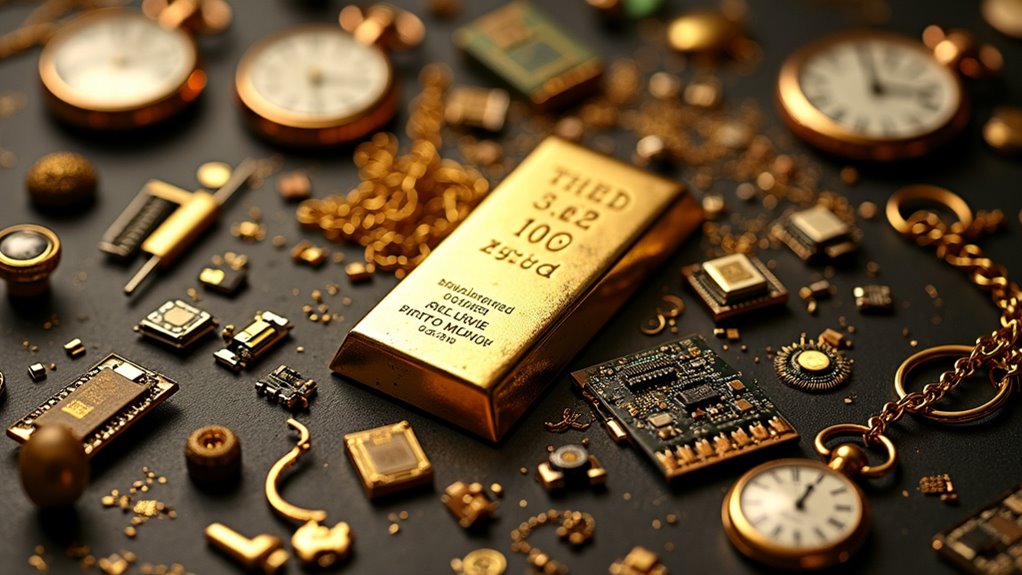The gold industry’s sustainability trajectory is being shaped by five key drivers: enhanced ESG standards, renewable energy adoption, innovative recycling methods, technological advancement, and fair-trade practices. Mining companies are increasingly embracing solar and wind power, while implementing AI-driven solutions and water conservation techniques. The sector’s focus on responsible sourcing, combined with stricter environmental regulations and community-centred approaches, signals a transformative future where sustainability and profitability coexist. Understanding these shifts reveals gold’s evolving role in our sustainable future.

As the gold industry grapples with mounting environmental pressures and evolving societal expectations, notable transformations are reshaping its future landscape. The sector’s commitment to sustainability is driving unprecedented changes, with renewable energy adoption leading the charge. Mining companies are increasingly embracing solar, wind, and hydroelectric power solutions, while simultaneously introducing electric vehicles into their operations to reduce their carbon footprint and align with global climate targets, including the Paris Agreement. Sustainable solutions are being implemented to ensure a balance between resource extraction and environmental protection. Moreover, the integration of renewable energy technologies is becoming a standard practice, further minimizing greenhouse gas emissions. Additionally, adherence to environmental regulations is critical for ensuring compliance and facilitating a smoother transition to sustainable practices.
The implementation of stricter Environmental, Social, and Governance (ESG) standards has become a cornerstone of the industry’s evolution. Governments worldwide are enforcing more rigorous regulations that demand greater transparency and accountability throughout the supply chain. These measures encompass extensive reclamation guidelines and emphasise the protection of local communities through fair labour practices, pushing the industry towards more sustainable methodologies.
ESG standards drive gold industry transformation, prioritizing transparency, community protection, and sustainable practices under intensifying global regulatory oversight.
A notable shift is occurring in the sourcing of gold itself, with recycling emerging as a vital component of sustainable production. The processing of electronic waste and old jewellery presents a viable alternative to traditional mining, considerably reducing environmental impact. Technological innovations in recycling processes are enhancing efficiency while meeting the growing demand for responsibly sourced gold.
Technological advancements are revolutionising mining operations, with artificial intelligence and automated machinery leading to improved resource efficiency. The development of non-toxic alternatives to cyanide in gold extraction processes demonstrates the industry’s commitment to reducing environmental hazards. Additionally, sophisticated water recycling systems are addressing concerns about freshwater usage and contamination, while advanced geoscience tools minimise unnecessary land disruption.
Fair-trade practices are gaining prominence as consumers and investors increasingly demand ethically sourced gold. These initiatives guarantee miners receive fair compensation and work in safe conditions, while actively combating child labour and exploitation in artisanal mining operations. The emphasis on supporting local economies near mining sites has created a positive ripple effect throughout the industry.
Global collaboration has become essential in driving sustainable practices forward. Industry stakeholders are working together to develop innovative solutions and share best practices. The focus on sustainability has led to the creation of new technologies and methodologies that not only benefit the environment but also enhance operational efficiency. Furthermore, the adoption of sustainable practices in artisanal mining is gaining recognition as a critical factor in reducing the industry’s overall ecological footprint.
As the industry continues to evolve, these collaborative efforts are proving instrumental in establishing a more sustainable future for gold production. The transformation of the gold industry reflects a broader understanding that environmental stewardship and social responsibility are not just ethical imperatives but key components of long-term success.
Through the adoption of renewable energy, strict ESG standards, recycling initiatives, technological innovation, and fair-trade practices, the industry is building a framework for sustainable operations that will shape its trajectory for decades to come.
Frequently Asked Questions
How Does Recycled Gold Compare to Newly Mined Gold in Terms of Quality?
Recycled gold matches newly mined gold in quality and purity, with both varieties refined to achieve near-100% pure gold content.
The refining process effectively rejuvenates recycled gold‘s properties, making it indistinguishable from freshly mined gold.
Unlike some recycled materials that degrade over time, gold can be infinitely recycled without compromising its integrity.
Both types undergo rigorous technical processes to remove impurities and meet identical quality benchmarks and certifications.
What Role Does Blockchain Technology Play in Tracking Sustainable Gold Production?
Blockchain technology serves as a powerful tool for tracking sustainable gold production by creating an immutable digital ledger of each gold bar’s journey.
The system records every transaction and transfer, from mine to market, while verifying ethical sourcing practices and environmental compliance.
Through molecular barcoding and digital tracking, blockchain guarantees authenticity and transparency, enabling consumers to trace their gold’s origins and confirm it meets sustainability standards.
Can Sustainable Gold Mining Practices Help Reduce Mercury Contamination in Ecosystems?
Sustainable gold mining practices considerably reduce mercury contamination in ecosystems through innovative technologies and improved methods.
Mercury Capture Systems achieve up to 95% reduction in emissions, while closed-loop processes prevent vapours from entering the environment.
Alternative extraction techniques like gravity concentration and thiosulfate leaching eliminate mercury use entirely.
These practises protect water quality, soil health, and biodiversity while safeguarding community wellbeing through reduced neurotoxic exposure.
How Do Fair Trade Gold Certifications Impact Local Mining Communities?
Fair trade gold certifications greatly transform local mining communities through multiple economic and social benefits.
Miners receive guaranteed minimum prices and premiums of $2,000 per kilogram, which fund community development projects. The certification process guarantees better working conditions, promotes women’s rights, and prohibits child labour.
Communities gain improved access to education, healthcare, and infrastructure, while democratic decision-making processes empower miners to have greater control over their operations and investments.
What Are the Energy Consumption Differences Between Traditional and Sustainable Mining?
Traditional gold mining consumes between 132-240 TWh of electricity annually, primarily relying on fossil fuels and carbon-intensive operations.
In contrast, sustainable mining practices integrate renewable energy sources like solar and wind power, markedly reducing energy consumption and environmental impact.
While sustainable methods require higher initial investment in infrastructure, they achieve lower operational costs and emissions per unit of gold produced through energy-efficient technologies and circular system designs.














